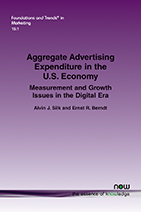Aggregate Advertising Expenditure in the U.S. Economy: Measurement and Growth Issues in the Digital Era
By Alvin J. Silk, Graduate School of Business Administration, Harvard University, USA, asilk@hbs.edu | Ernst R. Berndt, MIT Sloan School of Management and National Bureau of Economic Research, USA, eberndt@mit.edu
Abstract
The two components of the advertising industry – the creative sector that develops and produces messages, and the communications sector that transmits messages via various media – have each been greatly affected by advances in creative design and communications technologies. As the media composition of advertising has changed in the last century for both local and national advertising – from newspapers, outdoor and radio advertising to network and cable television, and most recently to internet and digital media – so too has been transformed the very concept of advertising, its functionality and its measurement.
We compare four sources of annual nominal U.S. aggregate advertising expenditure data – from the public sector Internal Revenue Service and the U.S. Census Bureau Survey of Service Industries, and the private sector McCann-Erickson and Magna Global advertising agencies – that are available over various time periods. In nominal terms, we estimate the elasticity of advertising expenditures with respect to Gross Domestic Product, and find that this elasticity appears to have increased substantially beginning in the late 1990s – from about 1.4 to 1.9. The timing of this structural break coincides roughly with the decline of print, radio and network and cable television, and the dramatic increase in digital and internet-based advertising.
To understand the forces underlying this structural break in nominal advertising expenditures, data on media-specific advertising prices are needed, thereby converting nominal to real advertising. However, currently annual U.S. Bureau of Labor Statistics Producer Price Index data on digital and many other advertising media prices are only available beginning in 2010. The availability of media-specific quality-constant price indexes would not only enable researchers to trace more completely the recent impact of digital and internet advertising, but would also facilitate contemporary and longstanding issues to be addressed surrounding the measurement of advertising effects, including how variations in the durability of response to advertising across media are related to inter-media price differentials, and why heterogeneity among firms and industries may arise with respect to the procyclicality of advertising policies.
Aggregate Advertising Expenditure in the U.S. Economy: Measurement and Growth Issues in the Digital Era
AGGREGATE ADVERTISING EXPENDITURE IN THE U.S. ECONOMY provides evidence that over the period 2000 through 2018 nominal aggregate advertising spending in the U.S. as a share of nominal GDP has been falling. The elasticity of advertising with respect to nominal GDP appears to have increased substantially since the late 1990s. The authors further show that nominal aggregate advertising spending has become more responsive to changes in real GDP and GDP price inflation. Finally, the monograph considers the implications of ongoing developments in the management of advertising campaigns and pending public policy issues surrounding controversial digital advertising practices for how advertising’s macroeconomic role may evolve in the future. The authors stress the development of media-specific and aggregate media mix prices indices as being the critical next step in advancing understanding of the sensitivity of aggregate spending on advertising to cyclical and secular shifts in total economic activity and the components thereof.
Following a short introduction, section II provides some historical background on the twin problems of defining advertising in the face of its ever-changing boundaries and measuring its output as a service industry. Section III sketches the vertical structure of the U.S. advertising industry and describes the set of four time series assembled that measure nominal aggregate advertising spending by advertisers and the related revenues of two sectors who function as service providers to advertisers -- advertising agencies and media firms. Section IV reviews the media price indices available from private sector sources and the BLS. Section V presents the double log constant elasticity model that serves as the conceptual framework underlying the analysis of the relationship of nominal aggregate adverting spending to GDP. Section VI reports extensive analyses of autocorrelation and partial autocorrelation coefficients calculated in order to assess whether the measures of nominal advertising spending exhibit stationarity and guide our choice of the order of moving average autoregressive function specifications. Section VII presents the results indicating that a structural shift in the sensitivity of nominal aggregate advertising to GDP occurred around the turn of the century when, in nominal terms, aggregate ad spending became more responsive to not only changes in nominal GDP but also to changes in real GDP and to changes in GDP inflation. Section VIII discusses implications of changes in the management of advertising campaigns accompanying the ascendancy of digital media and the resolution of public policy issues surrounding digital advertising practices. Section IX summarizes the main conclusions.
